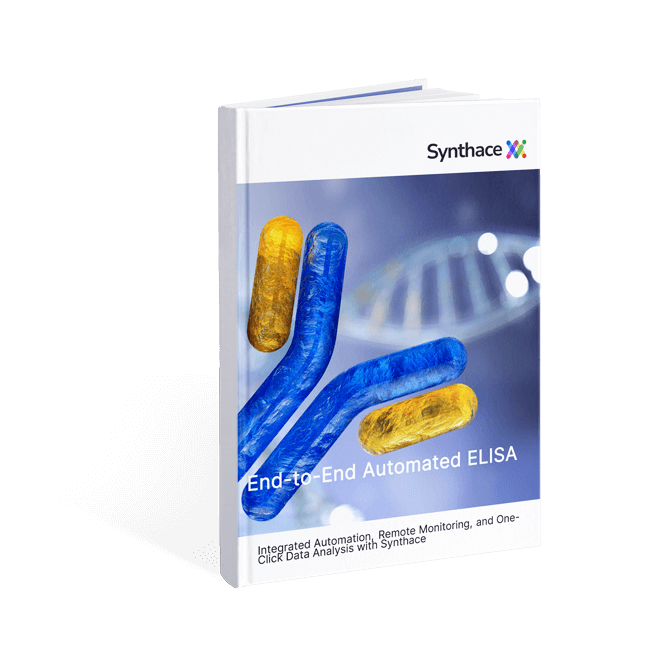Study Summary
Synthace delivers a fully digitalized ELISA experience.
The enzyme-linked immunosorbent assay (ELISA) is one of the most commonly used immunoassays for quantifying antigens. Traditionally, the assay has been performed manually, which is strenuous, time-consuming, variable, and error-prone. To address these pain points and empower scientists to perform faster, more efficient, and more robust ELISAs, we have built an automated, end-to-end ELISA solution using Synthace, our cloud-based software platform.
- Synthace performs end-to-end automated ELISAs and drives experiments from design to data analysis in a single platform
- Synthace links three independent devices into a responsive workcell - Synthace controls all devices required to perform an ELISA, shares status updates, and provides immediate feedback to the user through their personal computer
- 71% reduction in total hands-on time - Synthace dramatically reduced overall experimentalist time compared to manual execution, saving 98% of data analysis time, 61% of experiment planning time, 69% of assay execution time
- Higher dilution accuracy - Synthace improved dilutions compared to manual execution, resulting in better percentage recovery of samples quantifiedn
- 1.5-fold improvement in average interplate CV (%) - Synthace achieved a lower variability between technical replicates compared to manual runs

What is ELISA and what is it used for?
The enzyme-linked immunosorbent assay (ELISA) allows for the quantification of an antigen, typically a protein, in a sample. First described in 1971 [Engvall & Perlmann, 1971], it has become one of the most commonly used immunoassays as it is faster, more sensitive, and higher-throughput than other methods for protein quantification, such as western blotting.
ELISA relies on highly specific antigen-antibody interactions and, over the decades, the protocol has diverged into different formats depending on the capture and detection modes (direct, indirect, sandwich, competitive), each with their own advantages and drawbacks.
Shortcomings of Manual ELISA
an ELISA in the laboratory is often a strenuous and time-consuming process, relying on numerous incubation and wash steps that intensify with increasing plate numbers. In addition, a biological sample is often simultaneously assayed for differentproteins of interest, which can lead to complex assay designs that are error-prone.
Generally, scientists need to be highly trained to ensure high-quality and reproducible results. Even so, manual handling efficiency is invariably reduced over multiple plates which directly affects timing, leading to increased result variability. Complicating matters further, analysis can be repetitive and and requires extensive data formatting, aligning with sample metadata, and inputting into software programs, which is highly error-prone.
Power up your ELISA with Synthace
Synthace addresses the biggest pain points of running ELISA. From an experimental design point of view, Synthace enables the flexible combination of different antigen-antibody pairings, sample and standard dilution setup, and the quick and easy modulation of protocol parameters. Flexibility to support ELISAs in various formats (direct, indirect, competitive, cell based) is also built in within Synthace.
Download the Full Report for More Details
